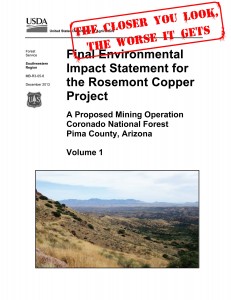The next post in a continuing series examining the significant failures in the Final Environmental Impact Statement (FEIS) for the proposed Rosemont Copper Mine and the serious damage that the mine would inflict on Southern Arizona’s water supplies, wildlife, mountains and economy.
A lake will be formed inside the mile-wide, half-mile deep Rosemont open pit copper mine after mining ceases that could become deadly to migratory birds and other wildlife, according to the Final Environmental Impact Statement (FEIS) for the proposed Rosemont Copper mine,
The Coronado National Forest Service, however, is not requiring Rosemont Copper Company, a subsidiary of Vancouver, B.C.-based Augusta Resource Corp., to eliminate the dangerous impacts from the potentially poisonous pit lake nor provide financial assurances that threats to wildlife and people are reduce or avoided.
Rosemont Copper is seeking state and federal permits to construct the proposed mine would on the northeastern flank of the Santa Rita Mountains on the Coronado National Forest about 35 miles southeast of Tucson.
After conducting a thorough and exhaustive review, a coalition that includes hydrologists, biologists, geologists and other experts, along with ranchers, business owners and conservation groups, filed objections to the FEIS on February 14. They say the Forest Service’s decision not to include in the FEIS a comprehensive, long-term, mitigation plan for what the agency believes will be a highly-contaminated pit lake violates the Forest Service’s own rules, the National Environmental Policy Act (NEPA), and other laws protecting wildlife especially for migratory and protected birds.
The coalition submitted their comprehensive objections to the U.S. Forest Service Regional Forester in Albuquerque, NM as part of the public review process of the FEIS. The regional forester must respond in writing to the objections before the Coronado National Forest can issue a Final Record of Decision for the proposed mine.
The experts who filed the objections have asked the Forest Service to prepare a new environmental analysis that requires Rosemont to prevent the creation of the toxic pit lake and set aside enough money to ensure that potential impacts to wildlife and ground water contamination are mitigated or avoided.
The Arizona Game and Fish Department has also raised concerns about the Forest Service’s decision not to mitigate damage from Rosemont’s pit lake.
The Forest Service states in the FEIS the pit lake will form after Rosemont ceases active groundwater pumping at the conclusion of mining operations estimated to be more than 20 years from when mining begins. The lake will contain various hazardous materials including cadmium, lead, copper, mercury, selenium, and zinc. (Page 664, Volume 3, Rosemont FEIS) The toxins, according to the FEIS, may be lethal to wildlife that come into direct contact with the water in the pit lake as well as lead to deaths from the contaminants getting into the food chain.
The “[w]ildlife groups that are most likely to be directly impacted by toxins potentially present in the mine pit lake include invertebrates (i.e., insects, etc.), birds, and bats,” the Forest Service says in the FEIS. “Wildlife most likely to be indirectly impacted includes any animals that prey on insects, birds, or bats that have come in contact with the water in the mine pit lake.”
The Forest Service also is not requiring a reclamation plan for the pit lake nor has it set a bond or other financial assurance plan to guarantee that Rosemont will cover the costs of ensuring that wildlife or area water supplies are not harmed.
The Forest Service’s decision not to address these issues in the FEIS is significant because it deprives the public the opportunity to review the financial assurances that should required of Rosemont. If Rosemont does not pay for the cleanup of the pit lake, then it is likely that taxpayers will.


2 Responses to Proposed Rosemont Copper Mine could create a toxic pit lake that won’t be mitigated